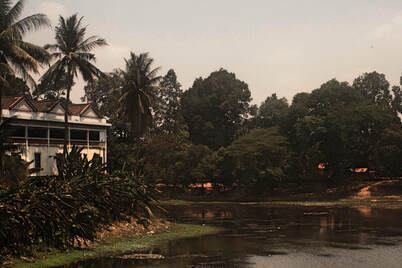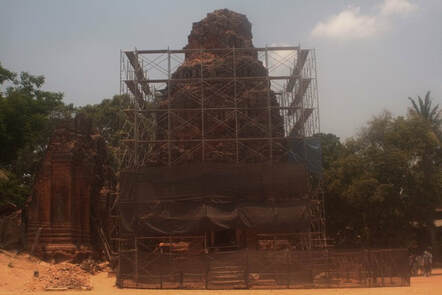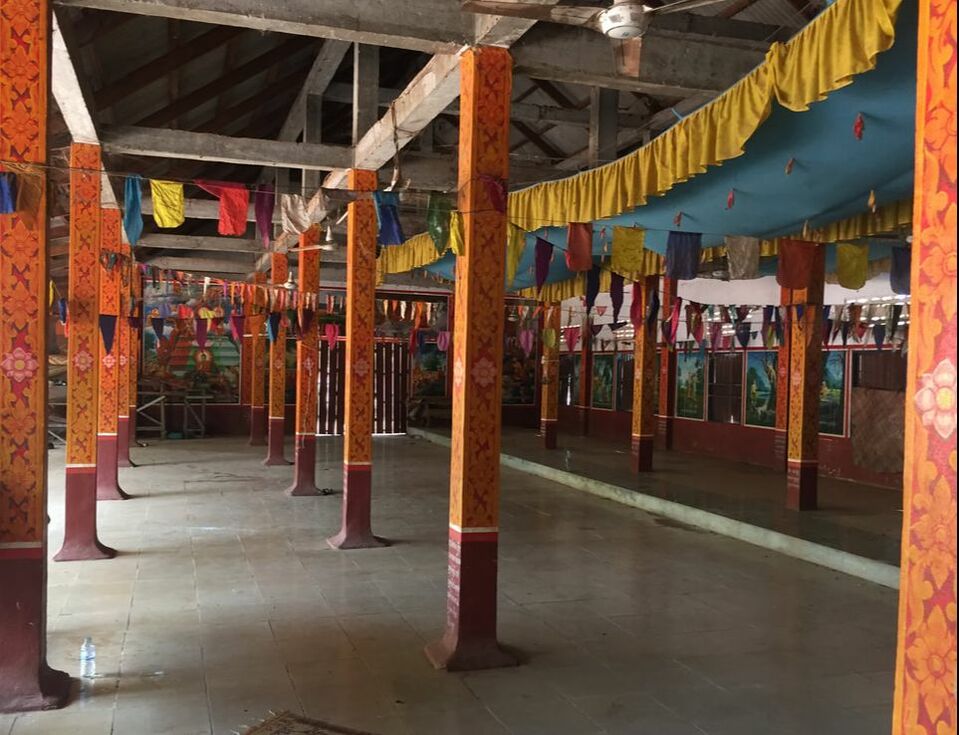Tales of Pacific Pride
 Mr Sareth's jail at Bakong Mr Sareth's jail at Bakong It’s 11am on Friday 11 January, and Sarah’s in the shower at our Sydney home, watching red dust from a pre-Angkorian temple site swirl around the chequered tiles and wash away. It’s not our usual homecoming; we’re the kind of travellers who prefer a final shower and some calm, tying up any loose ends before getting on the plane. We didn’t expect to visit any temples this trip; we hadn’t even bought a temple pass. So we’re still reeling from the day before, when a last-minute alignment of stars saw us go from our hotel to Angkor to the airport. Our Sydney friend Diana, in Siem Reap to supervise nursing students, had mentioned to us her friend Hun, a monk at Lolei Temple. Hun runs a school alongside the temple, and Diana thought he might be interested in having a choir visit. We were just finishing our packing and preparing for a spot of gift-shopping when Messenger pinged. It was Diana and Hun, with an invitation for us to visit Hun’s school that afternoon. Diana included a photo of the pre-Angkorian ruins she said were part of Hun’s monastery site. We recognised the reddish stone instantly as belonging to the Roluos Group - a collection of three of the oldest temples in the Angkor complex, and among Sarah’s favourites. We have to decide what to do - is it worth paying for a day pass to visit Hun on site for an hour on the way to the airport, or should we just chat more on Messenger? There’s only one way to do things properly though, and that’s in person. If Hun could make time to see us, then we should certainly make time to see him. And so we did. Mr Sareth, our driver, knows exactly where he’s going. We manage to run a little early, so he suggests we stop at all three of the Roluos temples, starting with Preah Ko, and then Bakong. Both Bakong and Lolei have monasteries attached to them. Sarah is particularly excited to see Bakong again - like most pagodas, the walls of the Bakong pagoda are covered in intricate murals depicting the lives of the Buddha or scenes from the Ramayana, but Bakong is especially beautiful. Mr Sareth pulls the car over near the bridge across the surrounding moat. He turns in his seat to face us. ‘Do you see the big white building there, and the one next to it? Khmer Rouge used them as a jail.’ ‘I know, because from 1978-1979, I was in that jail.’ We already know Mr Sareth lived through the Khmer Rouge. There’s a weird calculation that you start to do, usually at some point early on your first trip to Cambodia, where you realise that everyone over a certain age must be a survivor (unless they were out of the country). We’d both run this internal calculation on first sight of Mr Sareth: a small, nuggety man, well-muscled with a deep smile, he looks healthy and strong, but his hair is definitely greying. Although it took a couple of days, he’d already told us he was in jail under the Khmer Rouge by the time we pull up to Bakong, although he didn’t say where. In a flurry of last-minute changes, we’ve inadvertently brought him right to the doorstep of his own deepest trauma. Sarah thanks him for bringing us here, and we ask how he feels being here now. There’s that magnificent smile again; Mr Sareth shakes his head, taps it sadly and, still smiling, says, ‘Very big problems, in here’. The walk across the moat to see Bakong feels desperately sad. We shouldn’t be surprised by what Mr Sareth has told us - the Khmer Rouge turned every public building, including monasteries, into jails. We look at the murals, and sampeah to Buddha, all within view of the place in which Mr Sareth somehow survived, and countless others died, for no reason and in the deepest horror. Lolei was the last of the three late 9th-century Roluos Group temples to be built. Today, its four temple towers are behind scaffolding. There are monastery and school buildings where Mr Sareth parks and also on the higher terrace which holds the temple. Ascending the terrace, we realise it is surrounded by buildings, none of which we paid any attention to last time we visited. Hun is teaching Chinese to a group of school girls. We’ve never met a Cambodian Buddhist monk - at least not on a first-name basis - and we have no idea how to greet this smiling man in saffron robes, a friend of a friend, but also head monk. Before we know it we’re out the front of the class and it’s swapped from being a Chinese lesson to an English lesson. The girls - all either ten or twelve years old, we learn - shower us with questions, with only a little encouragement required from Hun. Their pronunciation is excellent. Mel attempts to draw a map of Australia on the whiteboard. Then one of the girls asks Sarah if she has a husband. ‘No, no husband,’ she replies. Dorothy McRae-McMahon’s oft-remembered words swim to the surface of our minds: coming out is not a one-off experience, it’s a constant choice. Do we choose to do it here, in the shadow of an ancient temple, standing next to a Buddhist monk, in front of a class of primary-school-aged Khmer girls? ‘I live with Mel. We are married - we can do that in Australia.’ The girls regard us steadily; we don’t know whether it’s their English skills that have failed them, or their comprehension of gay marriage. Hun says something to the girls in Khmer, and internally we both brace for, at best, giggles, at worst, grimaces. ‘I told them this is allowed in Australia, but also in Thailand, and also in Cambodia - free choice. Like in Buddhism.’ He breaks into his trademark grin. We look at the girls; they look back at us. They have complete trust in what Hun’s said. One little girl puts her hands over her heart and, fluttering her eyelashes, sighs as if we’ve just stepped out of the denouement of a Disney romance. Hun and his team of volunteers teach around 300 local school children: maths, English, Khmer, sewing, computers and Chinese. Around 25 orphaned boys board at the monastery. The school, called the Friendship Association for Cambodian Child Hope, also helps local kids with school materials such as uniforms, and even scholarships. Hun himself has a Masters in Economics, is articulate, and giant-hearted; his frequent smile borders on cheeky. He explains how he’s been working with Diana’s clinic - his job is to gain the confidence of patients who have been avoiding much-needed treatment in hospital. Many people struggle on with injuries or illness rather than temporarily deprive their families of a breadwinner; Hun has to help them understand the long-term consequences to them and their families if they don’t take time now. Apart from the orphaned kids in his care, Hun has seven cats (all boys too), and we’re not sure how many dogs. We slither down the ancient uneven steps to the prayer hall at the bottom of the temple terrace. Prayer flags flutter in criss-crossing strands across the ceiling and the walls surround us with brightly-painted scenes of the lives of the Buddha. Sarah sings a few notes but we already know we don’t really care about the acoustics. Hun says there are people in the surrounding villages who he thinks will benefit from hearing us. If he can make it happen, then we’ll sing at Lolei. Mr Sareth takes a back-street wiggle to the airport. At the end of the Khmer Rouge, he had the chance to move to America, but chose to wait in the hope of reconnecting with his family. None of them survived. We think of the family trees of Holocaust survivors we’ve seen, the single line surrounded by the blankness of generations rubbed out. The backstreet wiggle takes us past the little restaurant Mr Sareth’s eldest son and his new wife run. In a month, Mr Sareth will be a grandfather. He tells us about his wife, who only needs to shop at the markets once a week now because she can store everything in the fridge. Also we hear about his other children, all of whom are well-educated and in good jobs. Mr Sareth is doing well; there’s enough money for his family and when he has some left, he takes it back to his village and gives it to the poor people there. By way of farewell, Mr Sareth says, ‘I am happy now.’ We knew we were stepping into unfamiliar territory for ourselves, trying to set up a pride choir tour in South-east Asia. What we know from working with choirs is that behind even the most ordinary-looking of people, there’s a complex and compelling story. Making art together creates a space where some of these stories can come to the fore. We had little idea what we were doing or how to go about doing it when we arrived in Vietnam and Cambodia. But we did what we’re good at - hearing people’s stories - and have met people more brave, more generous, more decent, than you could ever imagine. Our stories and our lives are now linked - so will our voices be, come July. Our 2019 scoping trip to Cambodia ends here. Thanks for reading. To join us on the tour this July, follow the button on this page. To donate to Hun's school, click here.
0 Comments
Leave a Reply. |
Mel & Sarah
Currently blogging from home, in iso like everyone else, and catching up with PPC19 in the form of a daily photojournal. Archives
June 2020
Categories
|
Proudly powered by Weebly


 RSS Feed
RSS Feed